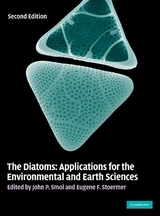
The Diatoms
Cambridge University Press (Verlag)
978-0-521-58281-0 (ISBN)
- Titel erscheint in neuer Auflage
- Artikel merken
Diatoms are microscopic algae which are found in virtually every habitat where water is present. This volume is an up-to-date summary of the expanding field of their uses in environmental and earth sciences. Their abundance and wide distribution, and their well-preserved glass-like walls make them ideal tools for a wide range of applications as both fossils and living organisms. Examples of their wide range of applications include as environmental indicators, for oil exploration, and for forensic examination. The major emphasis is on their use in analysing ecological problems such as climate change, acidification and eutrophication. The contributors to the volume are leading researchers in their fields and are brought together for the first time to give a timely synopsis of a dynamic and important area. This book should be read by environmental scientists, phycologists, limnologists, ecologists and palaeoecologists, oceanographers, archaeologists and forensic scientists.
Eugene F. Stoermer is a past-President of the Phycological Society of America and the International Association for Diatom Research. He has worked at the University of Michigan since 1965 where he is Professor in the School of Natural Resources and Environment, studying various aspects of diatom biology and ecology. John P. Smol co-heads the Paleoecological Environmental Assessment and Research Laboratory (PEARL) at Queen's University, Ontario, where he is Professor in the Department of Biology. He is editor-in-chief of the Journal of Paleolimnology.
Part I. Introduction: 1. Applications and uses of diatoms: prologue Eugene F. Stoermer and John P. Smol; Part II. Diatoms as Indicators of Environmental Change in Flowing Waters and Lakes: 2. Assessing environmental conditions in rivers and streams with diatoms R. Jan Stevenson and Yangdong Pan; 3. Diatoms as indicators of hydrologic climatic change in saline lakes S. C. Fritz, B. F. Cumming, F. Gasse and K. R. Laird; 4. Diatoms as mediators of biogeochemical silica depletion in the Laurentian Great Lakes Claire L. Schelske; 5. Diatoms as indicators of surface water acidity Richard W. Battarbee, Donald F. Charles, Sushil S. Dixit and Ingemar Renberg; 6. Diatoms as indicators of lake eutrophication Roland I. Hall and John P. Smol; 7. Continental diatoms as indicators of long-term environmental change J. Platt Bradbury; 8. Diatoms as indicators of water-level change in freshwater lakes Julie A. Wolin and Hamish C. Duthie; Part III. Diatoms as Indicators in Extreme Environments: 9. Diatoms as indicators of environmental change near Arctic alpine treeline André F. Lotter, Reinhard Pienitz and Roland Schmidt; 10. Freshwater diatoms as indicators of environmental change in the high Arctic Marianne S. V. Douglas and John P. Smol; 11. Diatoms as indicators of environmental change in Antarctic freshwaters S. A. Spaulding and D. M. McKnight; 12. Diatoms of aerial habitats Jeffery R. Johansen; Part IV. Diatoms as Indicators in Marine Estuarine Environments: 13. Diatoms as indicators of coastal paleoenvironments relative to sea-level change Luc Denys and Hein de Wolf; 14. Diatoms and environmental change in brackish waters Pauli Snoeijs; 15. Applied diatom studies in estuaries and shallow coastal environments Michael J. Sullivan; 16. Estuarine paleoenvironmental reconstructions using diatoms Sherri Rumer Cooper; 17. Diatoms and marine paleoceanography Constance Sancetta; Part V. Other Applications: 18. Diatoms and archaeology Steve Juggins and Nigel Cameron; 19. Diatoms in oil gas exploration William N. Krebs; 20. Forensic science diatoms A. J. Peabody; 21. Toxic harmful marine diatoms Greta A. Fryxell and Maria Célia Villac; 22. Diatoms as markers of atmospheric transport Margaret A. Harper; 23. Diatomite David M. Harwood; Part VI. Conclusions: Epilogue Eugene F. Stoermer and John P. Smol; Glossary; Index.
| Erscheint lt. Verlag | 29.4.1999 |
|---|---|
| Zusatzinfo | 12 Tables, unspecified; 3 Halftones, unspecified; 84 Line drawings, unspecified |
| Verlagsort | Cambridge |
| Sprache | englisch |
| Maße | 179 x 255 mm |
| Gewicht | 1083 g |
| Themenwelt | Naturwissenschaften ► Biologie ► Botanik |
| Naturwissenschaften ► Biologie ► Limnologie / Meeresbiologie | |
| ISBN-10 | 0-521-58281-4 / 0521582814 |
| ISBN-13 | 978-0-521-58281-0 / 9780521582810 |
| Zustand | Neuware |
| Haben Sie eine Frage zum Produkt? |
aus dem Bereich



